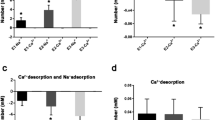Abstract
-
1.
When guinea pig cardiac tissue is stimulated, the rising phase of the action potential is influenced by the shape of the concomitant local surface electrogram. This, in turn, depends on the direction of the wave of excitation passing the recording microelectrode.
-
2.
A symmetrical biphasic surface electrogram yields sigmoid upstrokes with maximum upstroke velocity (V max) lower than when it is either zero or uniphasic and negative.
-
3.
When the main direction of the depolarization wave in guinea pig ventricular myocardium is receding from the recording microelectrode, giving rise to negative uniphasic extracellular potentials, a notch might distort the registration of the rising phase of the action potential.
-
4.
When the main direction of the depolarization wave is approaching the recording microelectrode, giving rise to positive uniphasic extracellular potentials,V max is transferred to less negative membrane potentials.
-
5.
The extracellular surface electrogram influences the overshoot of the action potentials of the normal atrial and depressed (D-600) ventricular myocardium and is changed, depending on how the wave of excitation passes the recording microelectrode.
Similar content being viewed by others
References
Alanis, J., Benítez, D.: Rate of rise of Purkinje and transitional cells action potential and the propagation across the Purkinje-myocardium junction. Jap. J. Physiol.20, 217–232 (1970)
Arlock, P.: Heterogeneity of guinea pig papillary muscle revealed by systematic variations in the upstroke of the action potential. Pflügers Arch.351, 351–356 (1974)
Bayer, R., Kalusche, D., Kaufmann, R., Mannhold, R.: Inotropic and electrophysiological actions of verapamil and D-600 in mammalian myocardium (III). Effects of the optical isomeres on transmembrane action potentials. Naunyn-Schmiedeberg's Arch. Pharmacol.290, 81–97 (1975)
Clementz, B., Grampp, W.: A method for rapid bevelling of micropipette electrodes. Acta Physiol. Scand.96, 286–288 (1976)
Clere, L.: Directional differences of impulse spread in trabecular muscle from mammalian heart. J. Physiol. (Lond.)255, 335–346 (1976)
Corbin, L. V., II, Scher, A. M.: The canine heart as an electrocardiographic generator. Dependence on cardiac cell orientation. Circ. Res.41, 58–67 (1977)
Hoffman, B. F., Cranefield, P. F.: Electrophysiology of the heart. New York-Toronto-London: McGraw-Hill, Inc., 1960
Martinez-Palomo, A., Alanís, J., Benitez, D.: Transitional cardiac cells of the conductive system of the dog heart. J. Cell Biol.47, 1–17 (1970)
Mendez, C., Mueller, W. J., Merideth, J., Moe, G. K.: Interaction of transmembrane potentials in canine Purkinje fibers and at Purkinje fiber-muscle junctions. Circ. Res.24, 361–372 (1969)
Nastuk, W. L.: Physical techniques in biological research. 5 (A), chapter 2: Microelectrodes for recording and stimulation by K. Frank and M. C. Becker. New York-London: Academic Press, 1964
Paes de Carvahlo, A., Hoffman, B. F., de Paula Carvahlo, M.: Two components of the cardiac action potential. I. Voltage-time course and the effect of acetylcholine on atrial and nodal cells of the rabbit heart. J. Gen. Physiol.54, 607–635 (1969)
Rosen, M. R., Ilvento, J. P., Gelband, H., Merker, C.: Effect of verapamil on electrophysiological properties of canine cardiac Purkinje fibers. J. Pharmacol. Exp. Ther.189, 414–422 (1974)
Spach, M. S., Barr, R. C., Serwer, G. A., Kootsey, J. M., Johnson, E. A.: Extracellular potentials related to intracellular action potentials in the dog Purkinje system. Circ. Res.30, 505–519 (1972)
Trautwein, W.: Über die Veränderungen der elementaren Daten der elektrischen Erregungswelle des Herzens bei der Insuffizienz des Myocards. Pflügers Arch. ges. Physiol.252, 573–589 (1950)
Weidmann, S.: The electrical constants of Purkinjie fibers, J. Physiol. (Lond.)118, 348–360 (1952)
Weidmann, S.: Electrical constants of trabecular muscle from mammalian heart. J. Physiol. (Lond.)210, 1041–1054 (1970)
Author information
Authors and Affiliations
Additional information
The work was supported by grants from Hierta-Retzius fond för vetenskaplig forskning, Kungliga Fysiografiska Sällskapet, Lars Hiertas Minne, Magnus Bergvalls Stiftelse to Per Arlock and from Statens Naturvetenskapliga Forskningsråd to Anders Edström (NFR B 2535-017).
Rights and permissions
About this article
Cite this article
Arlock, P. The influence of the surface electrogram on the rising phase of the mammalian cardiac action potential. Pflugers Arch. 380, 139–144 (1979). https://doi.org/10.1007/BF00582149
Received:
Issue Date:
DOI: https://doi.org/10.1007/BF00582149



